Baby Skin Care: 5 Tips for Preventing Rashes and Irritation
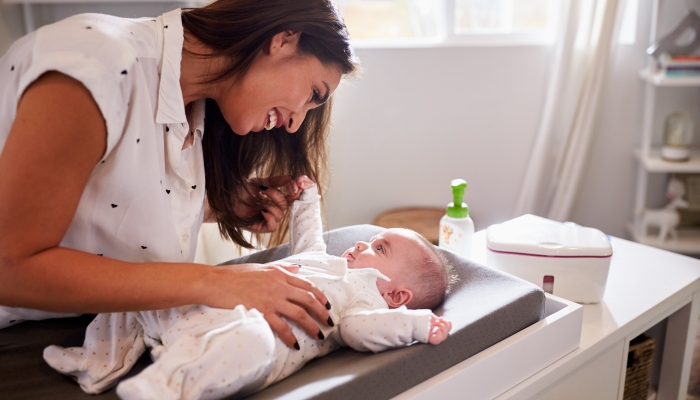
- Baby skin is more sensitive than adult skin and needs different care.
- Bathing a baby every day may make their skin dry and irritated.
- Using unscented lotions, soaps, and laundry detergent is best for sensitive skin.
- Keeping a journal when your baby develops a rash may help identify allergens or irritants.
While you may have your own skincare routine down to an exact science, caring for a new baby’s skin can feel confusing and overwhelming. With so many baby skin care products available, it is hard to know exactly which strategies, soaps, or lotions are really best for your baby.
Fortunately, baby skin care does not have to be complicated. There are only a few simple baby skin care rules you should follow to keep your baby’s skin soft, glowing, and rash-free.
1: The Right Bathing Technique and Products
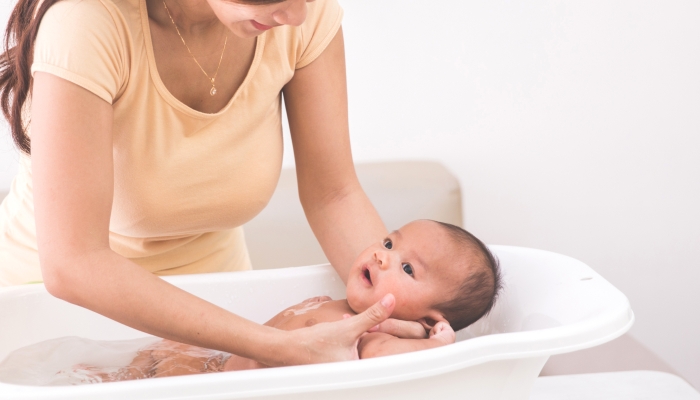
Many parents look forward to and enjoy bath time with their baby. The warm water is soothing, the soap smells nice, and bathing is a great opportunity for parents to bond with their new baby.
While newborns and infants do need to be washed, they should not be given a bath every day. Daily baths can dry out a newborn’s skin, making it more susceptible to flaking and cracking.
According to the experts at the Mayo Clinic11. Baby bath basics: A parent’s guide. Mayo Clinic. 2022. https://www.mayoclinic.org/healthy-lifestyle/infant-and-toddler-health/in-depth/healthy-baby/art-20044438#:~:text=How%20often%20does%20my%20newborn,dry%20out%20your%20baby’s%20skin., bathing your child every other day or even once every three days will allow his or her natural oils to hydrate their skin.
When you give your child a bath, keep the following tips in mind to avoid irritating their sensitive skin:
- Avoid baths that are too hot.
- Use gentle drying techniques.
- Use mild, fragrance-free soaps.
- Choose hypoallergenic cleansing products.
- Do not soak your baby for longer than 15 minutes.
If your baby’s skin is especially dry, you might consider an oatmeal bath or adding breastmilk to your baby’s tub water. Studies have found breast milk to help with healing eczema22. Kasrae, H., Amiri Farahani, L., & Yousefi, P.. Efficacy of topical application of human breast milk on atopic eczema healing among infants: a randomized clinical trial. International Journal of Dermatology. 2015;54(8), 966–971. https://doi.org/10.1111/ijd.12764 and diaper rash33. Farahani, L. A., Ghobadzadeh, M., & Yousefi, P.. Comparison of the Effect of Human Milk and Topical Hydrocortisone 1% on Diaper Dermatitis. Pediatric Dermatology. 2013;30(6), 725–729. https://doi.org/10.1111/pde.12118 in infants.
2: Moisturize Regularly
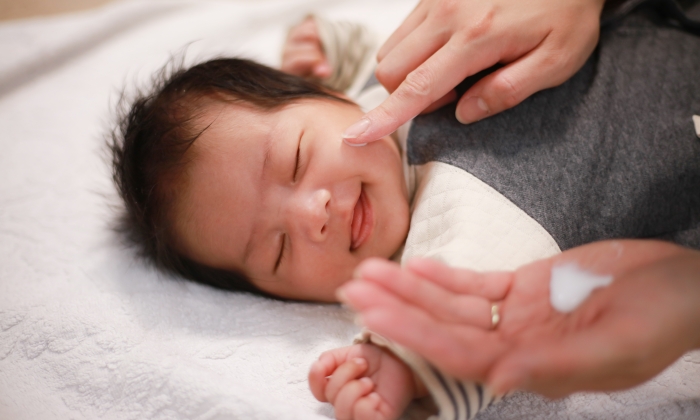
Research published in the Journal of Allergy and Clinical Immunology44. Horimukai, K., Morita, K., Narita, M., Kondo, M., Kitazawa, H., Nozaki, M., Shigematsu, Y., Yoshida, K., Niizeki, H., Motomura, K., Sago, H., Takimoto, T., Inoue, E., Kamemura, N., Kido, H., Hisatsune, J., Sugai, M., Murota, H., Katayama, I., … Ohya, Y.. Application of moisturizer to neonates prevents development of atopic dermatitis. Journal of Allergy and Clinical Immunology. 2014;134(4). https://doi.org/10.1016/j.jaci.2014.07.060 shows that babies who had a daily application of moisturizer were 32% less likely to develop eczema and atopic dermatitis by 32 weeks of age.
Moisturizing your baby right after they take a bath can keep their skin from drying out. Some parents love to moisturize their baby’s skin first thing as part of a bedtime routine.
However, it’s important to pay attention to the ingredients in the lotions you choose for your baby. Try choosing moisturizers that are designed for sensitive skin, are free from scents, and avoid harsh chemicals.
Some great products include Aquaphor and Eucerin cream. Name brand products are not necessarily best for your baby. If any moisturizer causes a rash or irritation, rinse the area with warm water and do not apply the product again.
3: Diaper Rash Prevention
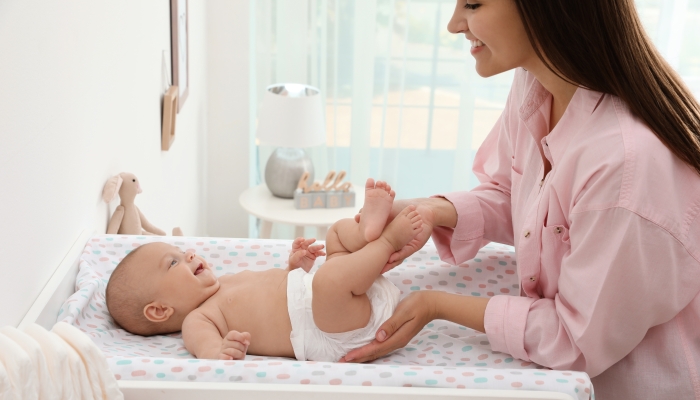
According to researchers, approximately 35% of infants55. Patient education: Diaper rash in infants and children (Beyond the Basics). UpToDate. 2024. https://www.uptodate.com/contents/diaper-rash-in-infants-and-children-beyond-the-basics/print#:~:text=Diaper%20rash,%20or%20diaper%20dermatitis,the%20child%20wears%20a%20diaper. between the ages of 9 and 13 months will develop a diaper rash at some point during infancy. While diaper rash is an extremely common problem, it is preventable.
The best way to prevent diaper rash is to make sure you keep your baby’s skin dry. Check your baby’s bottom frequently, and change it as soon as possible after they soil their diaper.
Some infants also develop rashes in their skin folds. Parents should pay special attention to their baby’s under arms, elbow crease, and behind the knees. Clean these areas daily with a washcloth and make sure to keep them dry.
If your baby does develop a diaper rash, there are a few things you can do:
- Remove your child diaper and let the area air out as much as possible.
- Apply a barrier cream to keep the skin away from moisture.
- Soak your baby in an oatmeal or breastmilk bath.
- Change to cloth diapers or diapers made for sensitive skin.
- Switch to fragrance-free wipes.
4: Laundry Care
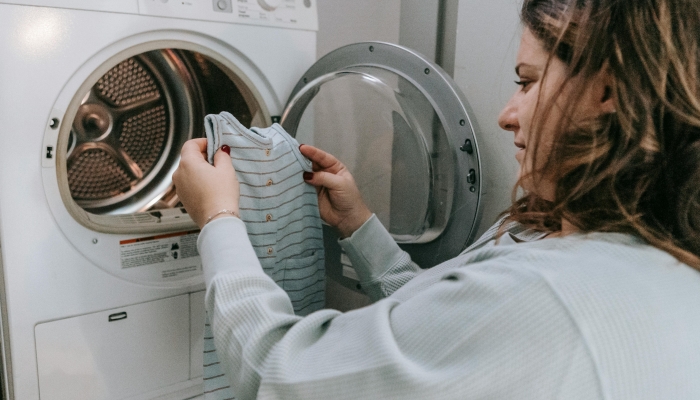
The laundry detergent you use can have a significant impact on the health of your baby’s skin. All clothing, towels, and bedding used for your baby should be washed using hypoallergenic, fragrance-free laundry detergents.
Some fabric softeners and sent boosters may also irritate your babies skin.
For infants and children with especially sensitive skin, parents can set their washing machine to double-rinse all laundry.
5: Avoid Allergens and Irritants
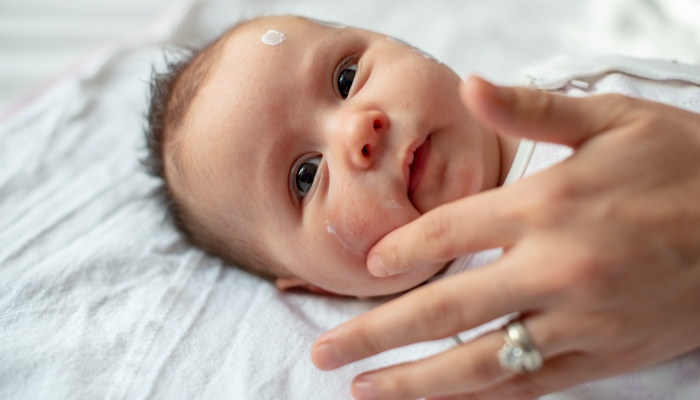
Children can develop allergies to dust mites, pollens, detergents, soaps, and many other substances. You may notice that your baby’s skin becomes irritated after wearing certain clothing, going outdoors, or spending time around certain pets.
If your child has sensitive skin, you can keep a journal with notes about activities, clothing, weather, surroundings, and your baby’s skin condition. After a few weeks of recording this information, you will be able to identify trends to pinpoint the cause of skin problems.
You may have to change detergents, eliminate certain clothing, avoid the outdoors on high pollen days, or rehome pets.
FAQs
Is it safe to use essential oils in my baby’s skincare routine?
Many adults love to use essential oils as part of their skincare routine. They may add a few drops to the bath, into a diffuser, add it to lotions, or rub it directly on their skin. However, it is not safe to use essential oils in your baby’s skincare routine.
Essential oils are not regulated or tested by a third party for safety. While many companies are cautious in their selection and use of ingredients, there is high risk to your baby when applying essential oils to their skin.
Can baby skin care products expire, and how does this affect their effectiveness?
Baby skincare products do expire. Most manufacturers recommend discarding their products by the printed expiration date, or 6 months after opening the package, whichever comes sooner.
Using expired skin care products or soaps may be unsafe and can cause rashes or breakdown of your baby’s skin. Never apply expired products to your baby.
What are the signs that my baby might be allergic to their skin care products?
Allergic reactions can vary based on the product and the severity of your child’s allergy. Most allergic reactions to skincare products will result in redness, itchy skin, blotchiness, or raised bumps.
Some severe reactions can cause blisters, skin peeling, or even anaphylaxis—a life threatening condition that cases breathing problems and dangerously low blood pressure.
If your child shows signs of trouble breathing, lethargy, or a full body rash, take them to the nearest emergency department right away.
References
- Baby bath basics: A parent’s guide. Mayo Clinic. (2022, February 10). https://www.mayoclinic.org/healthy-lifestyle/infant-and-toddler-health/in-depth/healthy-baby/art-20044438#:~:text=How%20often%20does%20my%20newborn,dry%20out%20your%20baby’s%20skin.
- Kasrae, H., Amiri Farahani, L., & Yousefi, P. (2015). Efficacy of topical application of human breast milk on atopic eczema healing among infants: a randomized clinical trial. International Journal of Dermatology, 54(8), 966–971. https://doi.org/10.1111/ijd.12764
- Farahani, L. A., Ghobadzadeh, M., & Yousefi, P. (2013). Comparison of the Effect of Human Milk and Topical Hydrocortisone 1% on Diaper Dermatitis. Pediatric Dermatology, 30(6), 725–729. https://doi.org/10.1111/pde.12118
- Horimukai, K., Morita, K., Narita, M., Kondo, M., Kitazawa, H., Nozaki, M., Shigematsu, Y., Yoshida, K., Niizeki, H., Motomura, K., Sago, H., Takimoto, T., Inoue, E., Kamemura, N., Kido, H., Hisatsune, J., Sugai, M., Murota, H., Katayama, I., … Ohya, Y. (2014). Application of moisturizer to neonates prevents development of atopic dermatitis. Journal of Allergy and Clinical Immunology, 134(4). https://doi.org/10.1016/j.jaci.2014.07.060
- Patient education: Diaper rash in infants and children (Beyond the Basics). UpToDate. (2024, February 7). https://www.uptodate.com/contents/diaper-rash-in-infants-and-children-beyond-the-basics/print#:~:text=Diaper%20rash,%20or%20diaper%20dermatitis,the%20child%20wears%20a%20diaper.
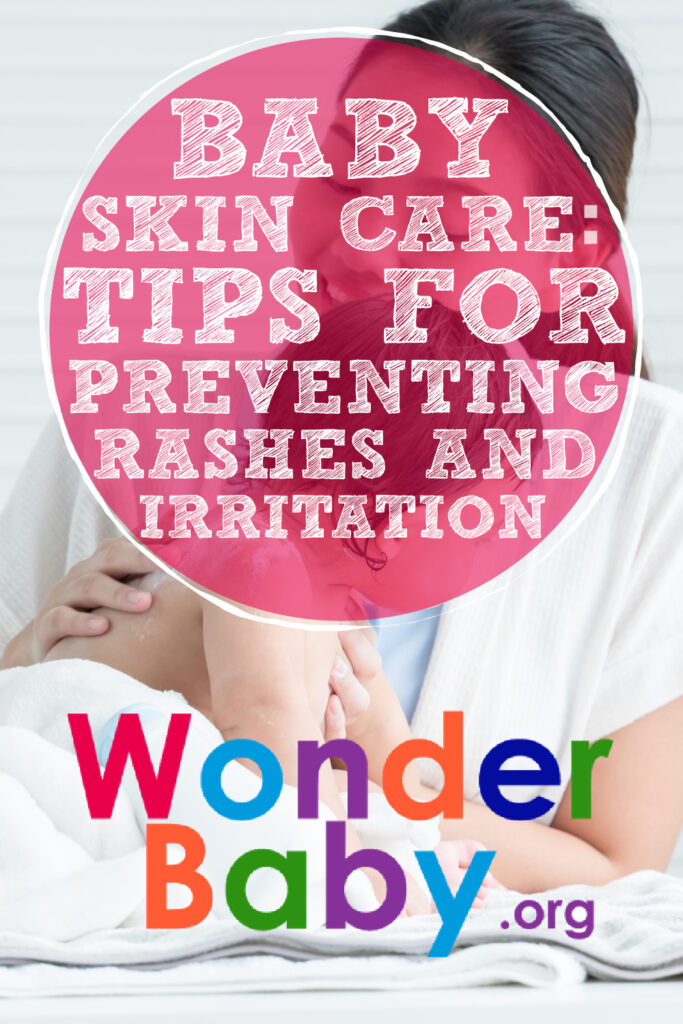
The information WonderBaby provides is not intended to be, and does not constitute, medical or other health advice or diagnosis and should not be used as such. Always consult with a qualified medical professional about your specific circumstances.
Related Posts

Eye Conditions and Syndromes, Visual Impairment
Neuralink Announces Plans to Restore Sight to the Blind with Brain Chip
Elon Musk’s company Neuralink has announced plans to begin human trials of its new “Blindsight” brain chip by the end of 2025.
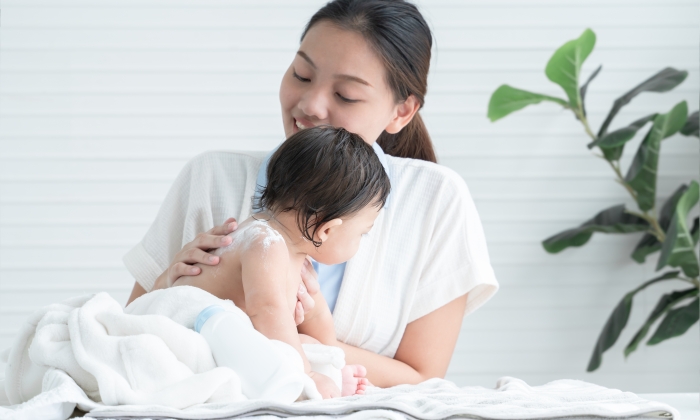
Health & Nutrition
Can Baby Skin Care Products Expire?
Is that forgotten tube of diaper rash cream still safe to use? Learn more about the expiration dates of popular skin care products for infants.

Health & Nutrition
Boosting Immunity in Kids: 3 Tips for a Healthy Winter
Parents can help boost their kids’ immunity during cold and flu season by maintaining healthy eating, sleeping, and exercising habits in the winter.